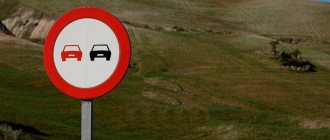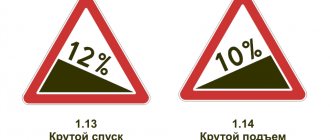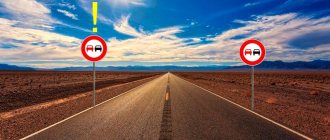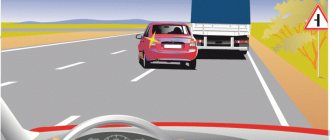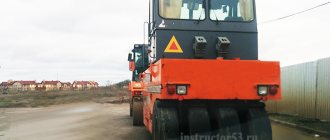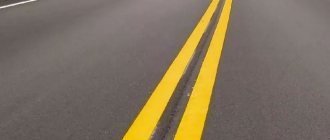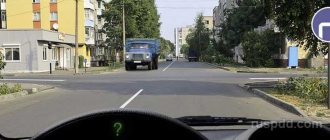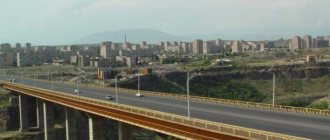When is it permissible to overtake a slow-moving vehicle?
The amendments made to the overtaking rules apply only to the “No Overtaking” sign.
Its effect applies to all types of vehicles, with the exception of motorcycles without sidecars, mopeds, bicycles, horse-drawn leashes and slow-moving vehicles. In the absence of this limiter, driving on a two-lane highway with solid marking lines 1.1 or 1.11 is subject to the same set of rules and wording as before.
There are four main cases in which we can talk about permission or a ban on overtaking a slow-moving vehicle:
If driving together with a slow-moving vehicle occurs in the area of the “Overtaking is prohibited” sign, then, in accordance with the changes, overtaking a slow-moving vehicle is allowed through a continuous road.
There are 1.1 or 1.11 markings on the road, but there is no sign regarding overtaking. This means that the amendments do not apply, and drivers driving behind a slow-moving vehicle are not allowed to overtake a slow-moving vehicle through a continuous road.
There is a 3.20 sign, and there is also a 1.1 or 1.11 marking. Here, as in the first paragraph, overtaking a slow-moving vehicle through a continuous marking line is permitted.
In the event that overtaking a vehicle is prohibited by any means other than sign 3.20, it is prohibited to overtake a slow-moving vehicle or any other vehicle. Amendments and exceptions do not apply here.
Overtaking a slow-moving vehicle may be prohibited if, for example, there are tunnels, bridges or other places with poor visibility. Or in a situation where there is at least one other vehicle in front of a car that wants to overtake and a slow-moving vehicle that is not overtaking.
The changes made to the traffic rules in 2015 had nothing to do with the issue of overtaking slow-moving vehicles, so at the moment it is the 2012 amendments that are relevant.
In what cases is overtaking allowed and in what cases is it not?
First you need to decide how overtaking differs from ahead. Some drivers confuse these two concepts and often cannot figure out exactly what maneuver they are performing.
Overtaking is the act of getting ahead of a vehicle that is moving in front of your car. But overtaking always involves driving into the oncoming lane and then returning to your lane.
Before overtaking, you must make sure:
- that the markings on the road allow this maneuver;
- that there is no car in the oncoming lane that will interfere with the maneuver;
- that the speed limit on this section of the road allows overtaking.
After a car traveling at a slower speed is left behind, the driver must return to his lane. In the Traffic Rules, the issue of overtaking is regulated in Art. eleven
Also, if the driver began an overtaking maneuver and saw:
- prohibitory sign “Overtaking is prohibited”;
- extending stripes of intermittent markings;
- oncoming car.
In any of these cases, the driver is obliged to slow down and return to his lane without completing the maneuver.
Advance means that the driver does not leave his part of the road and does not enter the oncoming lane. We can only talk about ahead when the road has two or more lanes in the direction in which the driver is traveling.
Having analyzed the situations described, any driver understands that overtaking is a more dangerous maneuver and requires the person behind the wheel to strictly adhere to the rules.
If we are talking specifically about ahead of a vehicle, without entering oncoming traffic, then such a maneuver is permitted at any intersection
If we talk specifically about overtaking, then such a maneuver is prohibited at a controlled intersection.
The legislator turned out to be very stingy with words when regulating the issue of overtaking at an intersection. In paragraph 4 of Art. 11 of the traffic rules states that overtaking is prohibited at uncontrolled intersections when driving on a secondary road and at controlled intersections.
But if there is no working traffic light or traffic controller at the intersection, then this intersection is considered unregulated and in this case other overtaking rules apply.
But if the road consists of two lanes in each direction and a car in the left lane overtakes a car moving in the right, then this maneuver is considered ahead. This means it is allowed at a controlled intersection.
Is overtaking on a broken line allowed? It is explained in the article: Is overtaking allowed on a broken line?
Read about the rules for overtaking at an intersection on the main road here.
Penalty for illegal overtaking
Overtaking in front of a pedestrian crossing is a traffic law.
Penalty for overtaking at a pedestrian crossing If you are in a situation where you really want to overtake a slow-moving vehicle, you should take a closer look, since it will not always be a slow-moving vehicle. However, if you know for sure that the vehicle in front of you has a maximum speed that does not exceed 30 km/h, then such a vehicle can be overtaken.
But you should be careful with this, otherwise you can earn a fine of 5,000 rubles regulated by Article 12.15 of the Code of Administrative Offenses, Part 4 for overtaking while crossing a solid line with possible deprivation of your driver's license.
In November 2010, and then in February 2012, a number of changes and amendments were included in the traffic rules regulating the rules for overtaking. In particular, it was allowed to overtake a slow-moving vehicle through a continuous road, but only if there was a “No Overtaking” sign. The purpose of this exception is to solve a known problem that occurs on small roads that carry a lot of rural, road repair and other slow traffic.
Typically, overtaking is prohibited in areas where an emergency situation may occur if the overtaken driver does not notice the overtaking person and suddenly accelerates. On unloaded suburban and rural roads, serious inconvenience is created by slow vehicles, behind which you can lose a lot of time. It is for these cases that amendments to the traffic rules have been introduced, allowing overtaking in certain situations.
Overtaking rules
These amendments apply only to sign 3.20 “Overtaking is prohibited”. If it is missing, when driving on a two-lane road with continuous markings 1.1 or 1.11, the old version of the rules applies. To clearly understand whether it is possible to overtake a slow-moving vehicle in certain situations, we will highlight four main cases:
- You are moving within the coverage area of the “No Overtaking” sign. In this case, a slow-moving vehicle can be overtaken.
- There is a continuous marking 1.1 or 1.11, but there is no sign 3.20. In this case, the exception does not apply - any overtaking through a continuous road is prohibited.
- The sign 3.20 is installed, and the road is marked with continuous markings 1.1 or 1.11. Overtaking a slow-moving vehicle is permitted.
- If overtaking on a section of road is prohibited under any other traffic rule, the exception does not apply.
What vehicles are classified as low-speed?
According to the definition, a vehicle whose rated speed does not exceed 30 km/h can be considered a low-speed vehicle. In this case, additional modifiers and restrictions are not taken into account. Even if, under certain conditions, a vehicle cannot (or does not have the right) to exceed this speed, it is still not slow-moving.
To designate slow-moving vehicles, the “Slow-moving vehicle” sign is used. It is a red equilateral triangle with a yellow or red reflective border. The inside of the triangle has a fluorescent coating.
Let's look at a couple of examples:
- The MTZ-80 tractor (known as "Belarus") with a loaded trailer moves at a speed of 15 km/h. It is quite obvious that he cannot accelerate sharply. However, the passport speed limit is 33.4 km/h, so this tractor is not slow-moving, and overtaking it is prohibited.
- The asphalt compactor is moving at 5 km/h, but the "Slow Moving Vehicle" decal is missing. Since this is the rated maximum speed, the roller can be clearly classified as a slow-moving vehicle and can be overtaken under the “No Overtaking” sign.
Thus, it is possible to determine whether a vehicle is slow-moving only by the corresponding sign (sticker), or by knowing exactly its factory technical characteristics. If you are absolutely sure that there is a slow-moving vehicle in front of you, in certain situations you can overtake it.
Typical situations
Overtaking at an intersection is regulated by just one short paragraph of paragraph 11.4 of the Rules:
11.4. Overtaking is prohibited:
- at controlled intersections, as well as at unregulated intersections when driving on a road that is not the main one;
There are regulated and unregulated intersections; at unregulated ones, the road can be the main and secondary one. The main road may change direction. It is important to remember that priority signs do not apply at signalized intersections:
So, overtaking at an intersection is prohibited when driving on a secondary road:
This situation can arise during rush hours, when on a small two-way road almost all traffic moves in one direction and the traffic goes in two lanes, and a simple rule is forgotten.
- Overtaking is prohibited when driving through an intersection of equivalent roads:
It is not uncommon that in small towns there are no priority signs on the roads, despite the fact that this is a violation of GOST requirements, and when driving along any main city road there are many secondary roads that intersect at first glance. However, this is not the case; all such intersections are equivalent and overtaking is prohibited at them.
It is also prohibited to overtake at any signalized intersections:
This rule just needs to be remembered, since many people associate a green traffic light with driving on the main road. This is not true. There are no main and secondary roads at the controlled intersection
And the situation when overtaking at an intersection is allowed is when driving on the main road:
This rule applies mainly on roads outside populated areas, but be careful, there are often continuous 1.1 markings before Nansesen intersections. It is prohibited to cross it.
Overtaking traffic rules for 2021 with comments
Overtaking a harvesting machine through a continuous field. Overtaking a slow-moving vehicle and continuous markings. Who is the real offender?
TS? — Answer: According to traffic rules: overtaking a trackless vehicle is allowed only on the left side;
“Is overtaking on the right allowed or prohibited?” — Answer: According to the traffic rules and the definition of overtaking and ahead of vehicles, when performing the so-called overtaking, you are actually ahead of the vehicle, and ahead of the right is allowed. Special cases of this issue:
- Overtaking on the right, like overtaking on the side of the road, is prohibited by traffic regulations.
- Overtaking on the right, as an obstacle to overtaking (example: vehicle No. 1 which is being overtaken in the oncoming lane, vehicle No. 2 must complete the overtaking, and vehicle No. must not interfere with the maneuver) is prohibited by traffic rules.
- Overtaking on the right, as changing lanes to the right, where it is a section of the road along which vehicles are moving in your direction and getting ahead of the car, is allowed.
On July 12, 2021, new rules for overtaking vehicles came into effect.
When do accidents occur more often when changing lanes?
What is the penalty for overtaking at a pedestrian crossing in 2019?
Outside populated areas, as well as in populated areas on roads marked with signs 5.1 or 5.3 or where driving at a speed of more than 80 km/h is permitted, vehicle drivers must drive them as close as possible to the right edge of the roadway. In addition, every motorist is obliged to know and understand how to behave if an accident does occur.
Conditionally. You want to occupy a lane in which a car is moving straight behind you. In this case, you must give way to him or increase the distance so as not to interfere with him when changing lanes.
In case of violation, the administration has the right to delete your answers and limit your account from using certain functionality.
Investigative Committee for Civil Cases of the Oryol Regional Court dated July 17, 2012 in case No. 33-1268). At the same time, there are more original ways to determine the degree of guilt of each driver.
At the intersection, when changing lanes, there was a complete collision, a European protocol was drawn up, and when at home I carefully looked at the recording from the DVR, I understood the sequence of my actions and I think that the second participant is also to blame, he did not stop at the final traffic light and moved without headlights, as a result of which he was not me noticed. There is video recording at the intersection. The accident took place on March 24.
Mazda ALREADY did not have the right to enter the intersection. Therefore, all other opinions of the court and the cops here are incorrect.
When committing an offense under Part 3 of Art. 12.27, the vehicle is detained and placed in a specialized parking lot (Article 27.13 of this document).
In many situations, analysis of an accident at an intersection when turning left cannot be carried out without a special forensic examination.
We got into an accident. Lost control. When changing lanes into the turn lane, the asphalt was removed and there were no warning signs; the road was also wet. As a result, there was a collision with a car coming out of a turn. We didn't have insurance, he only had compulsory motor insurance. Traffic police officers issued a protocol refusing to initiate an administrative case.
Perhaps the driver was looking for the right address, so he drove in an uncertain manner, and the author of the video, of course, should have waited a few seconds and let the “Kalinovod” make the maneuver. When turning left or making a U-turn, the driver of a trackless vehicle is obliged to give way to vehicles moving in the same direction from the opposite direction straight or to the right. Tram drivers should follow the same rule among themselves.
In this case, it is necessary to study all the materials of the case, since, based on your words, it is not clear how the administrative procedures for bringing to responsibility were carried out. Your guilt must be proven, Article 1.5 of the Code of Administrative Offenses of the Russian Federation. If there is irrefutable evidence, it is better to repent of what you have done and admit guilt, as well as compensate for the damage. In this case, a minimum sentence may be imposed. If there is a record from the registrar, this will be evidence that is difficult to get away from. . Perhaps you did not understand that an accident occurred - maybe you will have to play on this.
Don't forget that when changing lanes on multi-lane roads, you should look not only at the cars in the next lane, but also at the cars driving across the row. This will avoid simultaneous rebuilding and associated problems.
Mutual lane changes in sections of traffic rules are not considered separately, which means that they are carried out as prescribed in paragraphs 8.1 and 8.4.
When turning left or making a U-turn outside an intersection, the driver of a trackless vehicle must give way to oncoming vehicles and a tram in the same direction.
Often, accidents when overtaking and turning left occur for the following reasons:
- The driver who is driving around the turn speaks about this intention almost a couple of seconds before performing the maneuver.
- A driver planning to turn left makes a maneuver without assessing the situation behind him. He may not notice the vehicle that is already starting to overtake.
- The motorist who follows the turning vehicle has already taken an impressive speed to overtake and does not have time to reduce it in order to avoid a collision with the turning vehicle.
- A motorist driving to overtake tries to get around the turning car in time and collides with oncoming vehicles. This can happen, for example, due to an incorrect assessment of the speed of your own or another car. Or due to the driver’s ignorance of the priority of oncoming cars.
- A car making an overtaking maneuver takes on excessive speed and does not have time to slow down in front of the zebra crossing at the intersection.
Is overtaking allowed at an intersection?
Road intersections can be different: with and without traffic lights, signs, and different markings. Converging paths sometimes have different meanings. There are other nuances that determine the prohibition or the ability to overtake the vehicle in front.
On regulated and unregulated
A traffic light makes a complex area regulated. A policeman with a baton can also control traffic flows. Any maneuver in this zone must be performed with both circumstances in mind.
Whether overtaking is allowed at signalized intersections is easy to understand if you read subclause 11.4 of the traffic rules:
Overtaking is prohibited: at signalized intersections...
There are no exceptions here. At such an intersection, everyone drives in their own lane, without entering the oncoming lane.
This section may not have a traffic light. Whether overtaking is allowed at an uncontrolled intersection is determined by its features and traffic rules:
- If roads of different significance converge, the one driving on the main road can bypass another vehicle and enter the oncoming vehicle. In this case, there must be no signs or markings that prohibit maneuver. And the main road is to maintain the same trajectory.
- You cannot overtake while driving in a secondary direction. These cars are obliged to yield to those who move along the main road.
- If equivalent roads converge, the maneuver is prohibited for all vehicles. The right-hand rule applies here, therefore, overtaking is dangerous.
On a T-shape
Whether overtaking is allowed at a T-junction is determined not by its shape, but by its type:
- if this is the point of convergence of equivalent roads, there is no traffic light, the maneuver is prohibited;
- when crossing the main and secondary roads, it is permissible for those driving along the first one when it is straight, there are no signs prohibiting overtaking, or a solid line;
- in the same circumstances, the maneuver cannot be performed by those who are not traveling along the priority route;
- if there is a traffic light and a traffic controller is working, the action is prohibited.
More on AutoLex.Net:
Features of the “Paid parking” sign
On two-way
Whether overtaking is allowed at a two-lane intersection is also determined by paragraphs 11 and 13 of the traffic rules. You cannot pass passing traffic and enter the oncoming lane if:
- no traffic lights, equal roads;
- the car is driving along a secondary road;
- it moves in the main direction, but there is a 3.20 sign or a solid dividing line;
- There is a traffic light on the site.
Maneuvering at the junction of two-lane roads is acceptable for those driving along the main road when there is no 3.20 symbol and the markings are intermittent.
But it is possible to pass another vehicle at such an intersection without entering the oncoming vehicle. If for the sake of this the car changes into the adjacent passing lane, it will advance. And such an action is permitted under the conditions listed above. That is, you can bypass slower traffic by moving into a passing lane both on a controlled convergence of tracks, on a secondary road, and when the main road has changed direction. It is important that this does not create an emergency situation.
On equal and unequal
When they try to figure out whether overtaking is allowed at an equivalent intersection, they mean that there is no traffic light there. The right-hand rule according to clause 13.11 applies:
At an intersection of equivalent roads, except in the case provided for in paragraph 13.11(1) of the Rules, the driver of a trackless vehicle is obliged to give way to vehicles approaching from the right. Tram drivers should follow the same rule among themselves.
That is, we are not talking about a maneuver; it is dangerous in such a situation.
Whether overtaking is allowed at an unequal intersection depends on which road the car is traveling on:
- If it's on the main road, the maneuver is permissible. But the road should not change direction, and at the intersection there should be a prohibitory sign or continuous markings.
- If it is secondary, the maneuver cannot be carried out. Cars traveling along it must give way to those in the priority direction.
More on AutoLex.Net:
Where and what type of traffic stop sign is placed, types of road signs, how the driver is allowed to act at the sign 5.16
Traffic rules when changing lanes
However, in practice, the driver of a white car will have to make some efforts to prove his innocence. The best option is a video recorder installed in the car, which recorded the maneuvers of the orange car.
The car ahead was changing lanes in three-lane traffic from the far right lane to the middle one, and due to a traffic jam, it stopped in the middle of the dividing line of the lanes. The car coming from behind in the same right lane began to get ahead. The driver of the first car began to maneuver, trying to press further to the left. As a result, both cars were pressed against their rear fenders with damage. It is more difficult to determine the culprit of an accident if the road is multi-lane, or there are factors that can be interpreted in favor of any participant.
It is quite possible that the car on the left was initially in the middle lane and decided to speed up and not allow the car on the right to pass, and therefore was forced to move to the left and was unable to get through.
General rules for prohibiting overtaking
Of particular importance in ensuring road safety are not only and not so much the principles of correct overtaking, but the conditions under which this maneuver is strictly prohibited. These conditions can be divided into two groups:
1) general;
2) special.
Let's consider the first option first.
The general rules prohibiting overtaking include the requirements of signs, markings and principles for the location of vehicles on the roadway.
"No overtaking" sign (3.20)
A very clear and informative way to prohibit overtaking.
It is important to remember a number of circumstances related to this prohibitory road sign. — The “No overtaking” sign is valid from the place of its installation to the nearest intersection, the end of the populated area (place of installation of signs 5.24.1, 5.24.2), as well as to the “End of the zone of all restrictions” sign (3.31)
The most preferable way to terminate the sign is to install a special “breaker” sign “End of no-overtaking zone” (3.21)
— The “Overtaking is prohibited” sign is valid from the place of its installation to the nearest intersection, the end of the populated area (place of installation of signs 5.24.1, 5.24.2), as well as to the “End of the zone of all restrictions” sign (3.31). The most preferable way to terminate the sign is to install a special “breaker” sign “End of no-overtaking zone” (3.21).
— The “Overtaking is prohibited” sign has three exceptions: in its coverage area, overtaking of slow-moving vehicles, horse-drawn carts, and motorcycles without a side trailer is allowed.
— The “No Overtaking” sign does not prohibit overtaking.
Solid lines of horizontal road markings
Another clear way to prohibit overtaking.
A solid marking line (for example, 1.1 or 1.11) prohibits crossing itself; therefore, overtaking in such conditions is also prohibited.
Requirements of section 9 of the traffic rules “Location of the vehicle on the roadway”
On two-way roads with four or more lanes, entering oncoming traffic is prohibited. Therefore, overtaking is also prohibited.
And on two-way roads with three lanes (when the identity of the middle lane is not determined), only the middle lane can be used for overtaking.
Driving into the leftmost lane is strictly prohibited.
The above cases of prohibited overtaking are quite clear: the restriction on performing this maneuver is confirmed by real objects (signs or markings), as well as common sense and safety logic. Therefore, it is not at all difficult to remember these cases.
Overtaking at an uncontrolled intersection. Everything is not so clear
Despite the fact that the existing traffic rules were approved back in 1993 (Resolution of the Government of the Russian Federation of October 23, 1993 N 1090) and to this day they are constantly subject to changes in the existing wording, it can be noted that to this day their edition is not is perfect. For ordinary drivers, most of the changes made to the Traffic Rules are not significant, since often the essence of one or another requirement of the Rules does not change, but only some clarifying points appear, the significance of which can often be appreciated by those few whose activities are related to safety road traffic.
However, there are situations when the requirements of a specific paragraph of the Road Traffic Rules are stated quite transparently and do not have a double interpretation, but conflict with another paragraph of the same Rules.
For clarity, let’s consider a traffic situation that arises with almost any driver (Fig. 1):
Illustration 1.
The driver of car “B” intends to overtake the vehicles in front, namely cars “A” and “B”.
The lane intended for traffic in the oncoming direction is free; on the section of the roadway there is an intersection of an unregulated intersection of unequal roads, while car “B” is moving along the main road (road sign 2.3.3). Thus, taking into account the requirements of paragraphs of the Rules of the Road 11.1 (“Before overtaking, the driver must make sure that the lane he is about to enter is clear at a sufficient distance for overtaking and in the process of overtaking he will not create a danger to traffic and interference with other road users"), 11.2. (“The driver is prohibited from overtaking in cases where: the vehicle moving ahead is overtaking or avoiding an obstacle; the vehicle moving ahead in the same lane has given a signal to turn left; the vehicle following it has begun to overtake; upon completion of overtaking, it will not be able, without creating a danger to traffic and interference with the overtaken vehicle, to return to the previously occupied lane") and 11.4. (“Overtaking is prohibited: at signalized intersections, as well as at uncontrolled intersections when driving on a road that is not the main one...”) the driver of car “B” can begin to overtake vehicles moving ahead, and at the same time his actions do not comply with the points listed above of the Road Rules no movement will be seen.
However, in front of the moving car “B”, the driver of car “A” slowed down and turned on the left turn signal, which actually forces the driver of car “B” to slightly reduce the speed.
The driver of car “A”, as expected, indicated in advance that he intended to make a left turn maneuver (turned on the left turn signal), began to slow down in advance, looked in the rearview mirror, made sure that the car moving behind him was also slowing down and realized his intention to make a left turn . With all this, when approaching an intersection, traffic lanes begin to be separated by a solid marking line (1.1 - separates traffic flows in opposite directions and marks the boundaries of traffic lanes in dangerous places on the roads; marks the boundaries of the roadway where entry is prohibited; marks the boundaries of parking spaces for vehicles ).
Illustration 2.
As a result, the following traffic situation arises when the driver of the car performs a left turn maneuver, while the driver of car “B” performs an overtaking maneuver.
Provided that the driver of the car entered the lane of oncoming traffic before the start of the continuous marking line, formally no inconsistencies with the requirements of the Traffic Rules are seen in his actions.
Since he could not observe that car “B” moving in front of him, car “A” had signaled a left turn and intended to turn left. When the driver left the occupied lane and began the overtaking maneuver, he could find that the vehicle A ahead was about to turn left. However, in this situation, the driver of car “B” already has a “priority” position on the roadway, and the driver of car “A” must make sure before starting the maneuver that he will not create a danger to traffic or interfere with other road users. In this situation, the driver of car “B” performing an overtaking maneuver.
Even if the driver of car “A” was the first to turn on the turn signal, then, based on clause 8.2 of the Rules of the Road, he does not have any preferential rights over other road users. And if the driver of car “B” was the first to begin the maneuver, then the driver of car “A” must refuse to make the intended left turn, in accordance with the requirement of paragraph 8.1, until car “B” completes the overtaking maneuver.
In this case, it is possible that the driver of the car will have to make a complete stop of his car, which in turn may come as a surprise to the driver of car “B”, who, due to technical features, will not be able to provide such intense braking to prevent a collision with the rear of the car. A".
As a result, we come to the conclusion that the Traffic Rules boil down to the fact that whoever started the maneuver first “gets the advantage.”
Often the situation looks much simpler, car “B” drops out of the above diagram, and the driver of car “B”, when starting the overtaking maneuver, has the opportunity to see the left indicator turned on, moving ahead of car “A”, but ignoring this fact, he still begins the overtaking maneuver, which in the future, in overwhelming cases, leads to a traffic accident.
When analyzing this type of traffic accident, the technical possibility is established for the driver of the car, which is in danger of moving, to prevent the incident, in accordance with the requirement of clause 10.1 paragraph 2 of the Traffic Rules. And in the absence of such, the entire burden of responsibility for what happened will fall on the shoulders of the driver of car “A”. Who was driving calmly and as safely as possible, but due to the existing “contradiction” of the requirements of the Traffic Rules and a combination of circumstances, he may find himself in a rather difficult life situation.
Oncoming traffic
There is another case in the life of a driver - difficult oncoming traffic. The presence of an obstacle on the roadway forces you to drive around it in the oncoming lane. And here the “rule of common sense” applies: a driver in whose lane there is an obstacle is obliged to give way to an oncoming car.
Agree, this is a completely reasonable requirement.
However, not all so simple. According to the traffic rules, on sections of roads with steep descents and climbs, which are necessarily marked with appropriate warning signs (1.13 “Steep descent” and 1.14 “Steep ascent”), different rules apply. They may seem paradoxical, but this is a misleading impression.
Regardless of the location of the obstacle on the roadway, the driver moving uphill takes advantage; A driver moving downhill is required to give way.
Of course, this is a very “dangerous” rule. A driver moving downhill may simply forget about his duty in these conditions to give way to an oncoming car, which at that moment is taking advantage.
What were the creators of the traffic rules guided by in regulating the actions of drivers in this way? Here's what!
- Stopping on a climb means that starting up the hill will be very difficult.
- What if the handbrake (parking brake system) does not work when driving uphill?
- A car going uphill is overloaded. The driver will have additional difficulties starting on an incline.
- There is ice on the road. Or wet road surface. In such conditions, you can start to slip.
And in all the situations described, congestion may occur.
And from a purely human point of view: in any case, a driver moving downhill is in more comfortable conditions than his colleague going uphill.
Thus, the “advantages” of this rule are obvious. But there is one “minus” here - the driver’s memory. Therefore, the “golden rule” for every driver in the described conditions will be the following “double-edged” principle:
- If you are going downhill, give way to the oncoming driver (in case the oncoming driver remembers his right of way).
- If you are going up, don’t rush to take advantage (suddenly the oncoming driver has forgotten that he has to give way).
Summarizing the consideration of this extensive topic, we can draw one general conclusion: if the driver cares about his own safety, then when performing overtaking and advancing maneuvers, as well as difficult oncoming traffic, he will show maximum attentiveness, caution and caution. Naturally, adding to these positive qualities a clear knowledge of the requirements of Section 11 of the Road Traffic Rules
The video lesson will help you consolidate your knowledge on the topic of overtaking, ahead, oncoming traffic:
May be of interest:
Scanner for self-diagnosis of a car
How to quickly get rid of scratches on a car body
How to check a used car before buying
How to apply for an MTPL policy online in 7 minutes
Explanation
According to section 8 of the traffic rules “Starting movement. Maneuvering", turning right must be done from the extreme right position. Everything is fine with the car. But at the same time turn right if possible
should be performed as far as possible in the extreme position (strip). But here the car driver made a mistake when turning into the left lane, because he has the opportunity to turn along a more “right” trajectory.
As for the motorcyclist, a left turn can be completed in any convenient passing lane. However, before making this turn, the driver is also required to take the (now) extreme left position on the roadway. Due to its size, the driver of a two-wheeled motorcycle has the opportunity to press even further to the left in the left lane, otherwise he will have problems with his friend (he will simply “cut him off,” as they say). Conclusion: the motorcyclist also violates the rules of maneuvering by turning left not from the most extreme position in the lane
Road narrowing sign: how to understand it correctly
Please note that in the examples discussed above, the cars are located at an angle to the edge of the roadway, so identifying a car changing lanes is quite easy. https://www.youtube.com/embed/C3yjbmkzAbc
Moreover, the consequences of a head-on impact are always much worse than other types of collisions. In such cases, people often die, and cars are practically not subject to repair and restoration work.
To express your opinion on the topic of the material, check the box next to the words “As an expert” in the form on the left. Otherwise, the check mark should remain opposite the words “As a simple reader.”
What is there to think?! Classic rim; according to the rules, the RAV had to give way to the MAZDA as it was moving in a forward direction. However, MAZDA should not have entered the intersection when the signal was yellow. To those who object: “they say there was no way to stop.... “I note that MAZDA clearly exceeded the speed limit, most likely wanting to jump through the yellow light.
Is it possible to overtake at an intersection?
This issue of concern to drivers is discussed in section 11 of the traffic rules. You can overtake at intersections, but not at all. According to the rules, this is legal only at uncontrolled intersections, and a driver who wants to overtake must move along the main road. First, let's explain the basic concepts. An intersection is a place where roads intersect. It can be of different types - cross-shaped, T-shaped, with a dividing strip, with a circular motion. Intersections are also divided into regulated and unregulated.
We all know that using a hand-held cell phone while driving is illegal. Most people probably don't know that even having a cell phone on your lap and not using it is a crime. You have not used the vehicle's warning device correctly. And if your hand is outside the window, you have committed the crime of limb protrusion.
The indicators should be used when turning left, right or making a U-turn, but not necessarily if you are driving straight. But if it involves crawling along a stop line at an intersection to pass that ambulance, you'll still activate the red light camera. Your protests will fall on the collective rumors of the National Debt Office. You are still technically "running" a red light.
Overtaking is the advance of one or more cars, which requires entering the oncoming lane. It is assumed that then (after completing the maneuver) the overtaking driver will return to his lane. Changes in traffic rules regarding overtaking occurred at the end of 2010, but not all motorists have yet remembered their essence. Previously, it was believed that overtaking meant any departure from the lane occupied by a car. This is not the case now. For the maneuver you perform to be considered overtaking, it must meet the following criteria:
If you see this sign, technically there should be no vehicles traveling in the far right lane unless they are in the middle of passing a specific vehicle. If you're one of those jolts who gets kicked by splashing water on umbrella-clutching pedestrians as you drive past the pouring rain, go for it.
But splashing mud on passersby who are waiting for the bus, you will pay for it. They may be nursing a hangover, regretting the dodgy kebabs they consumed earlier, or simply tired of courting the kids; Whatever you do, don't sympathize with your passenger by suggesting they lean back in their seat to take a nap. Most likely, the body lying in the front passenger seat will no longer be wearing its seat belt, as it should be snug against the torso. Apparently this is as bad as not wearing one at all, and if your passenger is under 16 you will receive 3 demerit points as well as a fine.
- When overtaking another vehicle, the driver always advances it. But not every advance can be called overtaking.
- The main condition for overtaking is to enter the lane intended for oncoming traffic.
- To complete overtaking, the driver must return to the lane he previously occupied.
You should also pay attention to one point - overtaking is not allowed along the entire length of multi-lane roads. For example, if the road has four lanes (two in the same direction and two in the oncoming direction), then you have the right to legally not overtake, but get ahead at the intersection and outside it
How? Change from the right lane to the left and get ahead of passing traffic without entering oncoming traffic.
At which intersections is overtaking allowed?
And finally, on other document related material, the crime also cannot notify the Roads and Maritime Authority when you move the house. This is why they know where to send violation notices when you have violated any or all of the above.
What driver behavior gets under your skin that the government hasn't found a way to legislate? Want to ban My Family decorations from your rear windows? Silhouettes of girls on semi-trailers? Above: Historic Route 66 in Missouri. In general, it is very easy for a European visitor, not to mention a Canadian one, to get around and drive in the United States. Most of the signs are identical, starting with right-hand driving, while the network, wide and well maintained, makes driving very comfortable. However, there are a few key differences to highlight.
Overtaking at an intersection, pedestrian crossing, etc.: what is allowed, what is not and what is the fine
Let us remind you what overtaking is
Almost everyone has already learned this definition, but first, let’s briefly recall what overtaking is: according to traffic rules, this is “ the advance of one or more vehicles associated with entering the lane (side of the roadway) intended for oncoming traffic and subsequent return to the previously occupied lane (side of the roadway)
" That is, without entering the oncoming lane, the maneuver is not considered overtaking - it is simply ahead of the curve, and the traffic rules relating only to overtaking do not apply to it.
Where is overtaking prohibited?
The rules for overtaking and advancing are regulated by section 11 of the traffic rules, and specific places where overtaking is prohibited are indicated in paragraph 11.4. According to it, overtaking is prohibited:
- at controlled intersections, as well as at unregulated intersections when driving on a road that is not the main one;
- at pedestrian crossings;
- at railway crossings and closer than 100 meters in front of them;
- on bridges, overpasses, overpasses and under them, as well as in tunnels;
- at the end of a climb, on dangerous turns and in other areas with limited visibility.
It is worth considering that in most cases, areas where overtaking is prohibited are additionally marked with a solid marking line, which is prohibited from crossing. In addition, outside populated areas, no-overtaking zones for passenger cars may be marked with sign 3.20 “Overtaking prohibited” in combination with a solid marking line.
What other situations prohibit overtaking?
In addition to the ban on overtaking in certain areas, there is also a ban on overtaking in specific situations listed in paragraph 11.2 of the traffic rules. According to it, a driver is prohibited from overtaking if:
- the vehicle moving ahead is overtaking or avoiding an obstacle;
- a vehicle moving ahead in the same lane has signaled a left turn;
- the vehicle following him began to overtake;
- upon completion of overtaking, he will not be able, without creating a danger to traffic and interference with the overtaken vehicle, to return to the previously occupied lane.
These are simple rules to ensure the safety of this complex maneuver: you cannot overtake a car that is already overtaking (popularly called double overtaking), start overtaking when you are already being overtaken, and also try to overtake in which you are not sure. The latter also applies to situations when the driver completes overtaking through a solid marking line: as we know, such a maneuver is always absolutely prohibited, so when overtaking you need to carefully monitor the markings: 100 meters before the start of a solid marking, a long intermittent one will appear. Well, in case of violation of all these points in an accident, the driver who began overtaking under the conditions of the ban will be considered the culprit.
Where is overtaking allowed?
Based on traffic rules and logic, overtaking is allowed wherever it is not prohibited. Everything is clear here with simple situations - let’s concentrate on those that not all drivers understand.
For example, overtaking is allowed at an uncontrolled intersection when driving on a main road in conditions of sufficient visibility and subject to other rules.
. Some drivers believe that the intersection is an absolute no-overtaking zone, but this is not the case. If the intersection is unregulated (that is, there are no traffic lights), and the main road at it does not change direction (that is, remains straight), provides sufficient visibility and does not have other signs of a prohibition on overtaking (for example, a continuous marking line), then overtaking in allowed in this place.
In addition, overtaking is allowed after a railway crossing, subject to other rules.
. As stated above, overtaking is prohibited at a crossing and 100 meters before it, but if the road behind the crossing does not have a continuous marking line, then overtaking is allowed immediately behind it.
What is the penalty for violating the overtaking rules?
Punishment for violating the rules of overtaking is provided for in Article 12.15 of the Code of Administrative Offenses, namely parts 4 and 5, and the punishment is very severe. Thus, according to Part 4, driving in violation of traffic rules into a lane intended for oncoming traffic, or onto tram tracks in the opposite direction, with the exception of cases related to avoiding an obstacle, entails the imposition of an administrative fine in the amount of 5,000 rubles or deprivation of the right to drive vehicles for period from 4 to 6 months
.
Well, part 5 provides for punishment for a repeated violation: it entails deprivation of the right to drive vehicles for a period of 1 year, and if the violation is recorded by automatic control
– imposition of an administrative
fine in the amount of 5,000 rubles
.

